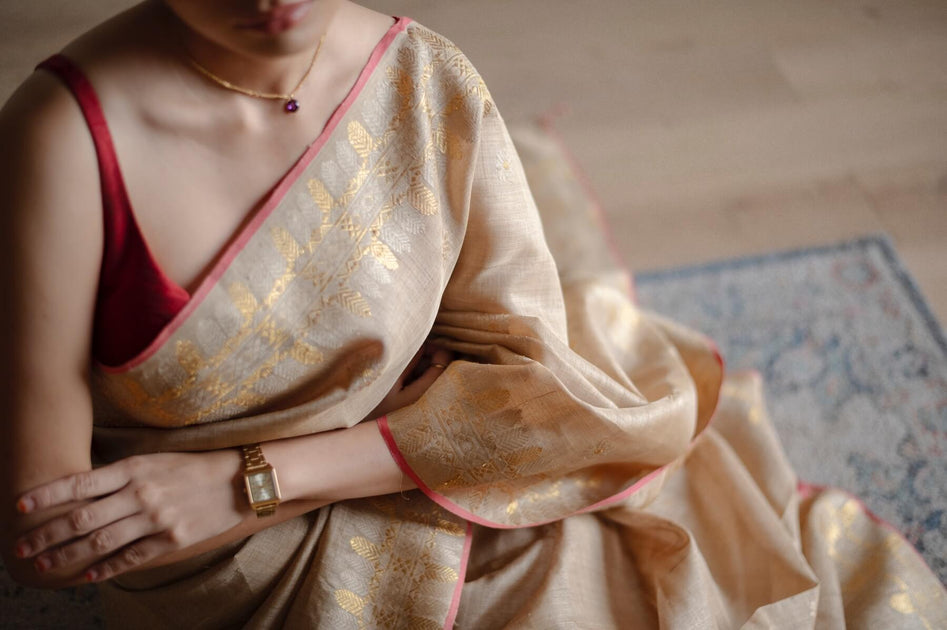The Silk Chamber’s Golden Heirloom
- Sumana Mukherjee
- 6 days ago
- 3 min read

Forget spectacle, if you grace an occasion wearing a Muga Silk Saree, a silent pause of reverence is what you get. A quiet recognition, perhaps, that you're witnessing something genuinely rare. The fabric catches light differently than other silks, holds its folds with an almost architectural precision, and emanates a warmth that no synthetic fabric has ever successfully replicated.
The Silk Chamber's Muga Heirloom Collection understands this quiet power. In curating their range of Muga silk pieces, they've resisted the urge to over-embellish or modernize beyond recognition. The collection trusts the fabric itself to do the speaking, which is precisely what Muga silk has always done best.

In Assam's lush valleys, where the Brahmaputra carves through ancient landscapes, a species of silkworm exists that produces something extraordinary. The Antheraea assamensis is endemic to this region and the cocoons it spins carry an inherent golden luminescence. This natural alchemy makes Muga silk coherent with a wedding collection, carrying within it the essence of Assam's unique ecology.
The craft of producing Muga silk has been refined over centuries, passed down through generations of Assamese artisans who've developed an intimate understanding of every stage in the process. Silkworms are nurtured on som and soalu leaves with devoted attention, their growth monitored daily. The reeling of thread from cocoons requires particular skill—too much force and the delicate filament breaks, too little and the thread won't separate cleanly. The weaving itself is an exercise in patience, with complex traditional patterns demanding weeks of concentrated work.

In Assam, there's a saying that Muga silk outlasts the wearer—and this isn't merely poetic exaggeration. Properly maintained, these creations can find places in wardrobes for multiple generations. The wedding saree becomes a tangible link across time, worn by grandmothers, mothers, daughters, each adding their own story to its history.

Supporting brands like The Silk Chamber becomes an act with consequences that extend beyond a single purchase. The economics of craft preservation are quite straightforward: artisans continue their work when it provides viable livelihoods. Every Muga silk piece sold sustains the weaver who created it, along with the entire ecosystem of skills and knowledge that makes its production possible. The sericulture farmers who tend the silkworms, the thread reelers who extract filament from cocoons, the dyers who work with natural materials for any additional colors, the designers who respect the history of the textiles—all depend on continued demand for their specialized expertise.

The modern Indian wedding has evolved into an elaborate production, with brides often acquiring dozens of outfits for various ceremonies and celebrations. This abundance comes at a cost, both financially and environmentally, with many pieces worn once before being relegated to permanent storage. Muga silk proposes a different calculus: fewer pieces of substantially higher quality and meaning. A single Muga saree might cost more than several mass-produced alternatives, but its value proposition extends across decades rather than ending after a single wear.
The golden silk of Assam has survived centuries of socio-economic shifts and transient fashion trends, but its continuation, like many such heritage textiles into the next generations, isn't guaranteed. The decisions made by today's brides—what they choose to wear, which brands they support, what stories they want their wedding attire to tell—will determine whether such extraordinary textile traditions persist or join the list of crafts that exist only in historical documentation.
Thanks to the dedication of Kakoli and the entire Silk Chamber Team, the ray of hope seems to be moving closer than the end of the tunnel.
Support our work on documenting Indian textile heritage—Buy our previous editions!











Comments